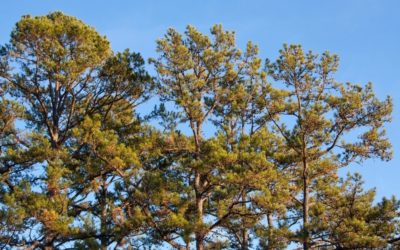Blog Topics
One of the highlights of spring in northern Virginia is when dormant trees explode into bloom. Bees are flinging themselves into scented flowers, colorful petals carpet the ground, and winter is just a memory.
If you want to add some beauty to your yard, you can’t go wrong with spring-flowering trees. To help you choose the right one(s), we’ve put together our top recommendations for easy-care trees that flower in spring in Loudoun and Fairfax Counties.
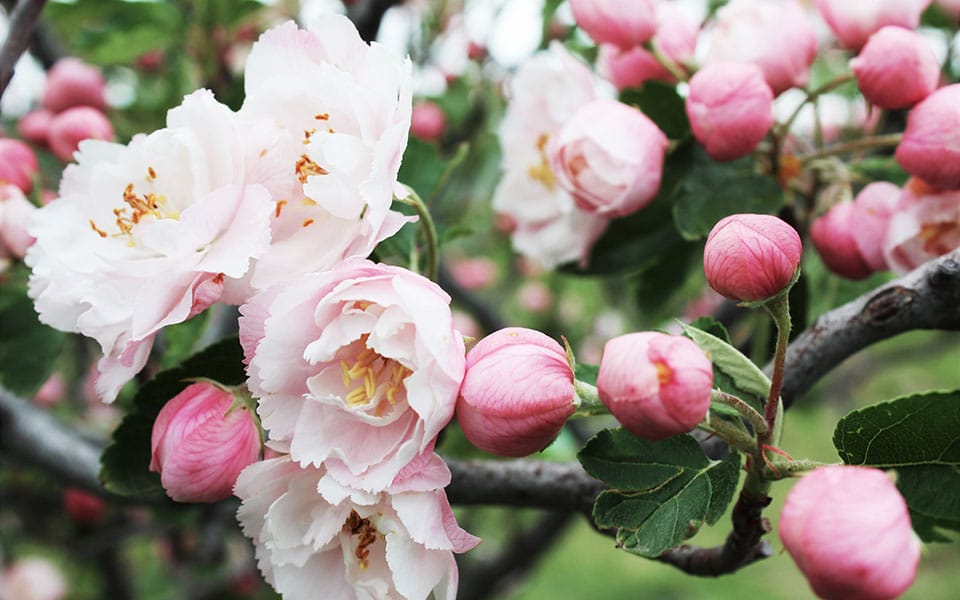
Apple
With over 20 varieties grown in the state, Virginia is among the country’s top apple producers. Northern Virginia is home to many commercial orchards and plenty of home fruit trees.
Apples (genus Malus) are known not just for their fruit, but also for the beauty of their spring blossoms. Flowers start out as dark pink buds then open to display pink-tinged white petals, whose scent attracts bees and pollinators like a magnet. Apples are in the rose family, so it’s no accident that clusters of apple blossoms resemble tiny rosebuds.
Recommended Apple Varieties
If you are considering adding apple trees to your home landscape, there are many varieties available that will thrive in northern Virginia. Some apple varieties grown locally include:
- ‘Red Delicious’
- ‘Golden Delicious’
- ‘Fuji’
- ‘Winesap’
- ‘Gala’
If you’re interested in the full range of apple varieties and where they grow best, Virginia Tech publishes a comprehensive article on apple growing in the state.
What to Look Out For
Growing apples at home is not difficult. However, to ensure your success be sure to choose varieties that are resistant to these common apple diseases:
- Fireblight
- Powdery mildew
- Apple scab
- Cedar-apple rust
Apple Tree Care
Apples need full sun to develop fruit, and grow best in well-draining soil with good fertility. Choose a spot in your garden that offers some protection from weather extremes and from strong winds. Plant your trees with enough space around them for air and sunlight to reach all parts of the tree’s crown (this helps cut down on fungal diseases and helps the tree grow more fruit).
Ensure that your apple trees get enough irrigation, especially when they’re getting established during the first year or two. Drought and excessive heat can cause fruit drop, and stressed trees attract insect pests.
Apples need regular pruning to form a strong branch structure and to encourage fruit production (if you’re not sure how to do that, give us a call!). It’s also a good idea to do regular checks for the common pests that damage apples.
With good garden care and a mix of apple cultivars, your garden or home orchard will give you showers of petals in spring and apples growing from early summer until well into fall.
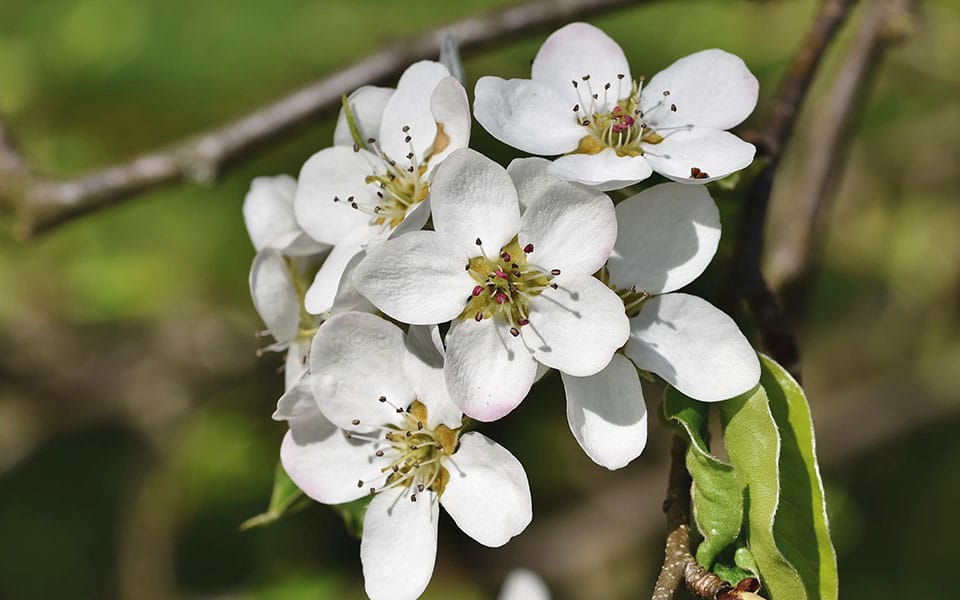
Pear
When choosing a pear (genus Pyrus) variety for your home garden, check your microclimate. Pears are susceptible to frost damage, so don’t plant them in low areas where cold air may collect. This is especially important for cold snaps that happen after fruit has set in spring.
As with apples, pear trees want well-draining soil and a location that receives full sun. Pear trees can tolerate more wet soil for longer periods than apple trees can, but should not be planted where water sits for more than a day or two.
And as with apples and other flowering trees in the rose family, pear trees with vigorous growth are more likely to be affected by fireblight. Make sure you’re not giving your pear trees too much nitrogen, which stimulates excessive green growth. There are also pear varieties that have shown resistance to fireblight; choose one of those if you can.
Recommended Pear Varieties
Suggestions for fireblight-resistant pear varieties that grow well in northern Virginia include:
- ‘Harrow Delight,’ a Bartlett hybrid with greenish-yellow skin, some blushing, and smooth flesh
- ‘Seckel,’ an older variety known for its excellent small fruit and its sweet and juicy flesh
- ‘Stark Honeysweet,’ a Seckel hybrid, with large, sweet fruit that has a natural russet surface and smooth flesh
NOTE: The most commonly available commercial pear varieties are not resistant to fireblight, so they are not listed here.
We do not recommend planting a Bradford pear. While it’s commonly grown, the Bradford pear has a number of problems that make it a very poor choice. Although it has beautiful spring flowers, those flowers smell terrible (kind of like dead fish). The tree gets much larger than other pears (up to 50 feet) so won’t be a good fit in smaller properties. It also has very dense branches (so nothing grows well under it, not even grass), and is structurally unsound (deep V-shaped branch crotches cause branches to break off and the tree to split apart).
As with many apple varieties, most pears are not self-fruitful (meaning they can’t pollinate themselves – you’ll need two trees). Unlike apples, pear flowers don’t have a lot of nectar that attracts pollinators, so you’ll want another pear variety close by (within 100 feet or so) for honeybees or other pollinating insects to visit.
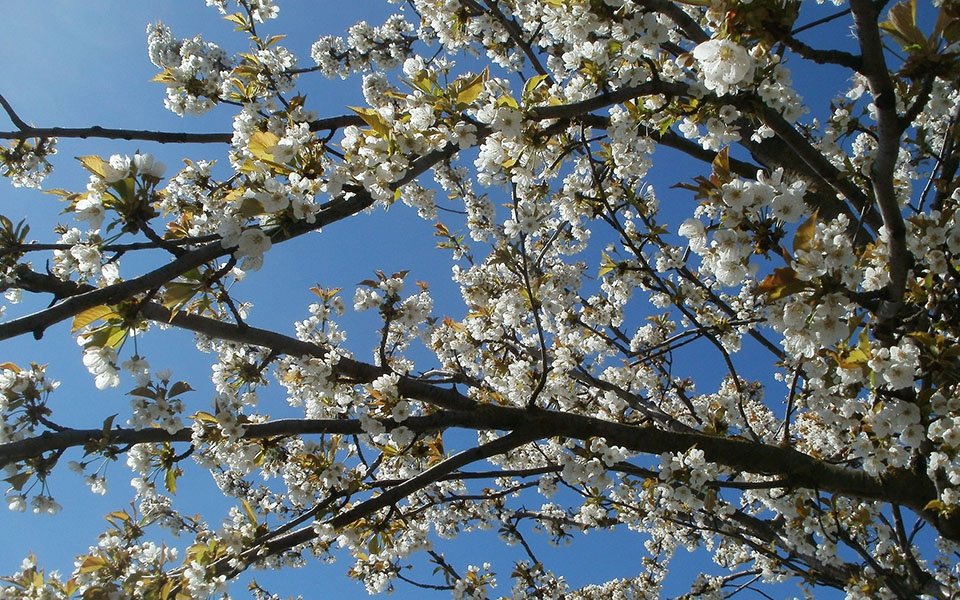
Cherry
Cherries have been grown in the U.S. since its earliest days as a colony, when seeds arrived with colonists. Today’s cherries are almost always grafted on rootstock (rather than being grown from seed), and new varieties are regularly developed. For many, ornamental cherry trees are as desirable for landscapes as fruiting trees, and in northern Virginia you can have either, or both!
When planting cherry trees, choose a site similar to what other fruiting trees prefer. Cherries need well-drained and fertile soil. They don’t like cold or wet feet so avoid planting in low spots where water and cold air collect. It’s also best to choose a location where there’s less risk of freezing when flowers and fruit are developing.
Unlike apples or pears, however, cherries are quite sensitive to climate and temperature and may be more difficult to grow. Cherry trees don’t want:
- Long periods of hot weather
- Warm winter temperature spikes during dormancy
- Temperature drops during bud break
- Rainfall when fruit is ready to harvest
So make sure your garden provides conditions that will keep cherry trees healthy and productive, and don’t forget to make plans to protect your tasty cherry crop from sharp-eyed birds!
Cherry Trees With Edible Fruit
The Montmorency cherry, Prunus ‘Montmorency,’ is the most popular cherry grown in Virginia and is ideal for home orchards. It is a sour cherry that’s good for juice, pies, and jams. Among the dozens of cherry trees Thomas Jefferson grew at Monticello, Montmorency cherries were among his most preferred.
Montmorency cherry trees have the following characteristics:
- Mature growth to 20’, with a spread of 15’
- Fragrant white spring flowers
- Dark green leaves with orange fall color
- Attractive dark red bark in winter
- Bright red fruit with a yellow interior
Fruiting Cherry Trees (Non-Edible)
The native black cherry, sometimes called wild cherry, Prunus serotina, grows to 60’ or more, often in places where birds have dropped seeds. It is a valuable tree for fine woodworking and its fruits are an important food source for wildlife, but the tree isn’t grown in garden orchards.

Ornamental Cherry Trees
Ornamental flowering cherries are selected for their stunning spring flower displays, their fragrance, and their fall foliage. Their fruit is not showy, but is loved by birds.
Several varieties of flowering cherry grow well in northern Virginia, including the Yoshino cherry (Prunus x yeodensis). This is a rounded, graceful tree that reaches 30’ or more in height and spread. Its explosion of fragrant, white or pink flowers in spring is breathtaking, and its small, bitter fruits are attractive food for songbirds. The Yoshino cherry is the most common cherry planted at Washington, D.C.’s iconic Tidal Basin.
If you plant a Yoshino cherry at home, make sure it has enough room to grow to its full size, and position it where its stunning spring bloom can be admired. As a specimen tree, it will provide you with beauty all year, from flowering to golden fall leaf color, as well as its dark, winter bark that shows off its graceful deciduous branch structure.
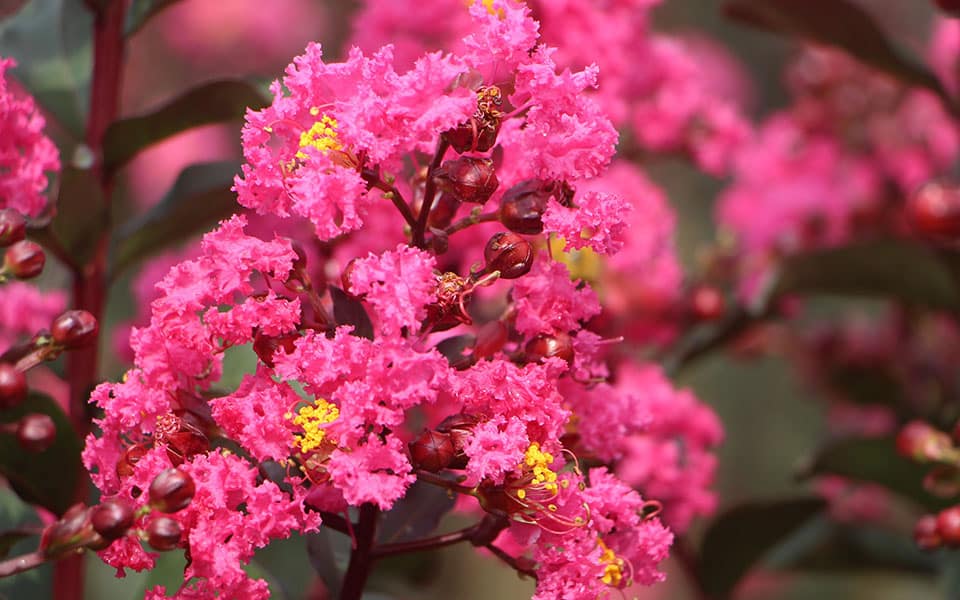
Crape Myrtle
Crape myrtle (Lagerstroemia indica) is a small- to medium-sized, shrub-like tree with year-round attractiveness. Depending on the cultivar or hybrid type, crape myrtles grow 1’-2’ a year to reach heights from 10’ to 40,’ with varying branch spread and form. Its common name is spelled in several ways, including “crepe myrtle” and “crapemyrtle.”
Spring and summer: Crape myrtles unfold with smooth, dark-green leaves in spring, leading to an explosion of showy flowers that continue into late summer. Flowers are borne at the ends of branches in large panicles, or spikes, ranging in color from white, pink, and lavender to deep red and purple.
Fall: When temperatures cool, crape myrtle leaves turn bright shades of golden yellow, orange, and red before falling.
Winter: Crape myrtles are prized for their exfoliating, or peeling, bark, where gray-brown outer bark is shed to reveal lighter brown or reddish inner bark. The trees are deciduous and their striking bark is on display in winter, when branches are bare and trunks are exposed.
Crape myrtles are used as garden and parkway trees, in border and mixed perennial planting beds, as an informal screening tree, and as specimen or accent tree where its showy flowers are highlighted.
The National Arboretum in Washington, D.C. has developed many named crape myrtle cultivars and hybrids that you can find here.
What to Look Out For
Generally a sturdy tree, crape myrtles are susceptible to a few pests and diseases, including:
- Powdery mildew
- Leaf spot
- Chlorosis
- Aphids
- Root rot
As with many pests and diseases that afflict trees, good tree planting practices such as fertile, well-drained soil, mulching, and proper pruning reduce the likelihood that your trees will suffer from these. Our certified arborists and tree-care professionals will give you the most useful—and correct—information about best practices for your garden trees.
A NOTE ON PRUNING CRAPE MYRTLE TREES
Crape myrtles in more temperate areas, such as Virginia, are often subjected to pruning methods that are incorrect and extremely damaging. In fact, you’ve probably seen many crape myrtles “pruned” this way and may have thought that it’s an accepted pruning practice for these kinds of trees. It’s not.
Sometimes referred to as “crape murder,” the practice of cutting most of the tree down to large stubs will damage, and can even kill, your crape myrtles.
No tree should be cut back to an arbitrary shape or height, or have its branches made into stubs, without consideration of its natural budding and branching patterns and its mature height and spread.
No ISA-certified arborist or competent tree-care professional will prune or “top” your crape myrtles this way. Besides damaging your tree’s appearance, this type of pruning leaves branches open to diseases and pests, as your trees cannot easily seal off and cover these types of cuts. This danger is compounded when crape myrtles are cut back during warm weather when insects and fungal pathogens are active.
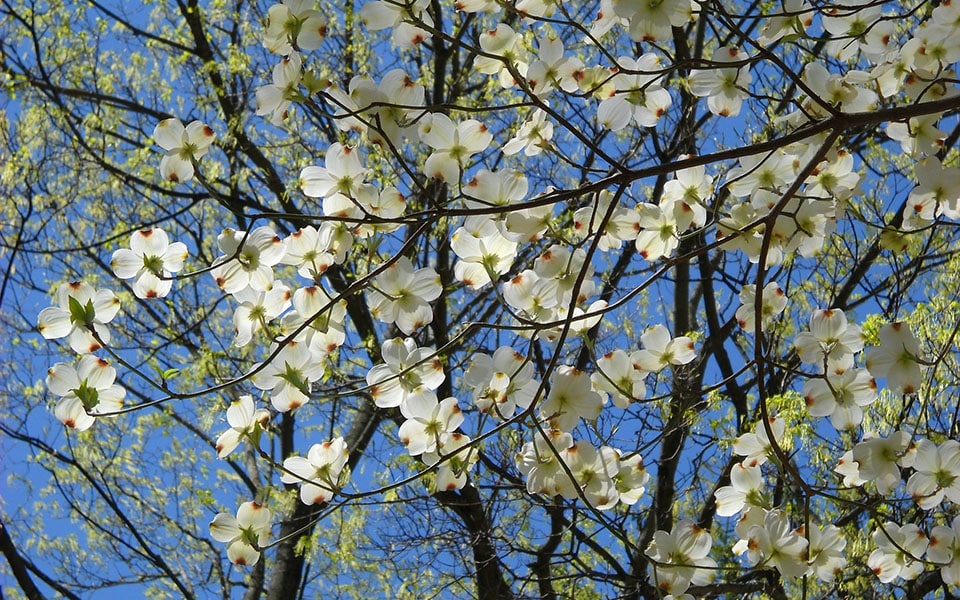
Flowering Dogwood
American Dogwood (Cornus florida) was adopted as the state flower of Virginia in 1918. Commonly known as “flowering dogwood,” it is a beautiful, small-scale deciduous tree. American dogwood typically grows 15’ to 30’ tall and has a round, spreading form with a low branching habit. Its native range spreads from Maine south to Florida and west to Texas and Mexico.
Dogwoods flower early, before their leaves emerge. With their clouds of blooms held above slender, bare branches, flowering dogwoods are a breathtaking welcome to spring.
The dogwood’s true flowers are tiny, yellow-green, and clustered in the center of the four showy white or pink bracts that we think of as petals. These 2” bracts open flat with the true flower held above, inviting pollinators. Oval, dark green leaves (3-6” long) turn attractive shades of red in fall. The fertilized seeds of flowering dogwood form clusters of bright red berries that last through winter and are enjoyed by birds.
Flowering dogwoods are excellent in northern Virginia landscapes, and are particularly useful as:
- Specimen or accent trees
- In border beds and patios
- Understory trees at edges of woodland or forest areas
What to Look Out For
If you use flowering dogwood as an ornamental tree in urban or suburban gardens, keep an eye out for these common problems:
- dogwood borer
- anthracnose
- powdery mildew
- crown rot and canker
As with most garden trees, good planting practices and maintenance will go a long way in preventing pests and diseases from damaging your flowering dogwoods. Plant dogwood as an understory tree in part shade, or as a full-sun accent tree in an area protected from strong winds and excessive heat. Well draining, acidic soil and sufficient irrigation, along with fertile soil and mulch will keep the dogwood’s root system strong, and will encourage flowering and a healthy crown of leaves.
How We Can Help
We love trees, and our job is to take care of them. If you’re interested in planting spring-blooming trees in your garden, we can recommend the best ones for your specific conditions. If you have existing trees, we can help ensure their health and longevity through our tree healthcare services.
Our professionals include ISA-certified arborists whose job is to keep your landscape thriving and healthy with fertilization, pest management, root health, and tree pruning that adheres to the best practices approved by the International Society of Arboriculture.
Give us a call at 703-402-9366 – we’re always happy to help!
Give Us a Call at 703-402-9366
If you'd like help with your trees or landscape, have any questions, or would like to schedule an appointment with one of our Certified Arborists, please give us a call. We'd love to hear from you!

